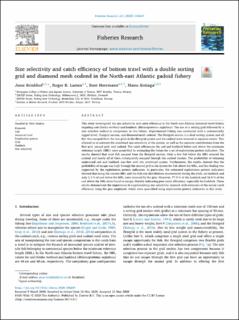| dc.contributor.author | Brinkhof, Jesse | |
| dc.contributor.author | Larsen, Roger B. | |
| dc.contributor.author | Herrmann, Bent | |
| dc.contributor.author | Sistiaga, Manu | |
| dc.date.accessioned | 2020-08-30T14:17:42Z | |
| dc.date.available | 2020-08-30T14:17:42Z | |
| dc.date.created | 2020-08-24T10:12:54Z | |
| dc.date.issued | 2020-11 | |
| dc.identifier.citation | Fisheries Research. 2020, 231 . | en_US |
| dc.identifier.issn | 0165-7836 | |
| dc.identifier.uri | https://hdl.handle.net/11250/2675583 | |
| dc.description.abstract | This study investigated the size selectivity and catch efficiency in the North-east Atlantic demersal trawl fishery targeting cod (Gadus morhua) and haddock (Melanogrammus aeglefinus). The use of a sorting grid followed by a size selective codend is compulsory in this fishery. Experimental fishing was conducted with a commercially rigged trawl, flexigrid section, and diamond-mesh codend. The flexigrid section is a dual sorting system and all fish that escaped from the two grids in the flexigrid system and the codend were retained in separate covers. This allowed us to estimate the combined size selectivity of the system, as well as the separate contributions from the first grid, second grid, and codend. The catch efficiencies for cod and haddock below and above the minimum reference length (MRL) were quantified by estimating the values for a set of exploitation pattern indicators. The results showed that most fish escaped from the flexigrid section. Only a few fish below the MRL entered the codend and nearly all of them subsequently escaped through the codend meshes. The probability of retaining undersized cod and haddock was low with the combined system. Furthermore, the results showed that the probability of escape was high through the second grid in the system for fish above the MRL, and this finding was supported by the exploitation pattern indicators. In particular, the estimated exploitation pattern indicators showed that using the current MRL and the fish size distributions encountered during the trials, no haddock and only 2.3 % of cod below the MRL were retained by the gear. However, 77.4 % of the haddock and 16.0 % of the cod above the MRL were found to escape, thereby indicating poor catch efficiency, especially for haddock. These results demonstrate the importance of supplementing size selectivity research with estimates of the actual catch efficiency using the gear employed, which were quantified using exploitation pattern indicators in this study. | en_US |
| dc.language.iso | eng | en_US |
| dc.publisher | Elsevier Ltd | en_US |
| dc.rights | Navngivelse 4.0 Internasjonal | * |
| dc.rights.uri | http://creativecommons.org/licenses/by/4.0/deed.no | * |
| dc.subject | Cod | en_US |
| dc.subject | Demersal trawl | en_US |
| dc.subject | Exploitation pattern | en_US |
| dc.subject | Grid | en_US |
| dc.subject | Haddock | en_US |
| dc.subject | Size selectivity | en_US |
| dc.title | Size selectivity and catch efficiency of bottom trawl with a double sorting grid and diamond mesh codend in the North-east Atlantic gadoid fishery | en_US |
| dc.type | Journal article | en_US |
| dc.type | Peer reviewed | en_US |
| dc.description.version | publishedVersion | en_US |
| dc.rights.holder | © 2020 The Author(s). Published by Elsevier B.V. | en_US |
| dc.source.pagenumber | 9 | en_US |
| dc.source.volume | 231 | en_US |
| dc.source.journal | Fisheries Research | en_US |
| dc.identifier.doi | 10.1016/j.fishres.2020.105647 | |
| dc.identifier.cristin | 1824728 | |
| cristin.ispublished | true | |
| cristin.fulltext | original | |
| cristin.qualitycode | 1 | |

